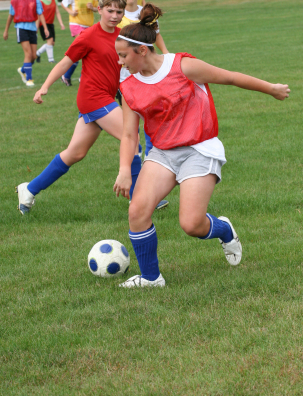Soccer has a higher injury rate than many contact/collision sports such as field hockey, rugby, basketball, and football, with players younger than age 15 at higher relative injury risk compared with older players, concludes a clinical report in the February 2010 journal Pediatrics.
Injuries by the numbers
- 186,544 soccer-related injuries in 2006
- 80% affect players under age 24
- 44% of injuries to players under age 15
- Injury rates:
- 2 injuries per 1,000 for players under age 12
- 4 to 7.6 injuries per 1,000 player-hours for players older than 12 years
- 4.0 injuries for girls' soccer teams over course of season
- 3.5 injuries for boys' soccer team over course of season
- No particular position on field at higher risk
- Indoor and outdoor soccer:
- have similar level of risk
- knee injuries more common in outdoor socce, likely due to field surface and shoe characteristics
- Injury rates for female players about the same as for boys in one study, higher in another
-
Girls:
- at 2.8 and 6 times greater risk of anterior cruciate ligament (ACL) tears;
- suffer more concussions than boys1; and
- are more likely than boys to be injured in practice
- Boys
- are more likely than girls to be injured in competition
- suffer more ankle injuries than girls
- Fatalities associated almost exclusively with traumatic contact with soccer goalposts.
Concussions
- Rate among elite and recreational players similar to that in football and ice hockey
- Significant under-reporting likely
- Female high school soccer players at slightly higher risk of concussion than male players1
- No return to play guidelines specific to soccer
- Collision, not heading, most likely cause
- Heading does not support contention that purposeful heading leads to either acute or cumulative brain damage.
Fair play
- Injury risk greater where fair play rules not followed
- Foul play associated with significant number of contact-related injuries
- In one study, girls (11.9%) and boys' (11.4%) soccer had the highest rates of injuries as a direct result of an illegal activity as ruled by a referee or disciplinary committee, behind only girls' basketball (14%).
- Expert consensus that officials controlling the physicality of game and emphasis on safe play with respect for one's opponent can both play significant roles in reducing contact injuries.
Safety recommendations
- Follow knee-injury risk-reduction programs to reduce knee injuries to female soccer players
- Anchor goalposts according to manufacturer and CPSC guidelines.
- Enforce rules and promote sportsmanship and fair play
- Teach heading only when child is willing to learn proper technique and has developed coordinated use of his or her head, neck and trunk to properly contract the neck muscles and contact the ball with the forehead
- Be aware of and enforce concussion return to play guidelines
- Protective eyewear recommended; should be mandatory for athletes with only 1 functional eye or past history of major eye surgery or trauma.
Source: Kouteres C, Gregory A, & AAP Council for Sports Medicine and Fitness, Pediatrics 2010;125(2): 410-414.
1. A new 2011 study found that the concussion rate for girls playing high school soccer over the 11-year period studied (1997 to 2008) was double (0.35 per athletic exposure) than the rate for boys (0.17 per AE). Lincoln A, Caswell S, Almquist J, Dunn R, Norris J, Hinton R. "Trends in Concussion Incidence in High School Sports: A Prospective 11-Year Study" Am. J. Sports Med. 30(10) (2011), accessed January 31, 2011 @ http://ajs.sagepub.com/content/early/2011/01/29/0363546510392326.full.pdf+html
Created September 25, 2010; revised and updated February 1, 2011








